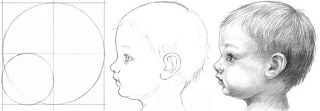How many times have you tried to draw a person, and finally given up in frustration saying ?I can?t get this right?? Be patient with yourself and don?t give up! Mastering figure drawing may take several years; however, with practice, your skills gradually improve and your drawings of people begin to look better and better.
Thursday, March 24, 2011
Sketching Figures with Lines
Rough, gesture, or action sketches are usually rendered very quickly, sometimes in less than a minute. The benefits of making rough sketches are in the process, rather than the creation of a magnificent work of art. Hence, you only goal is to capture a mood, expression or gesture on your drawing paper.
Tuesday, March 15, 2011
Friday, March 11, 2011
Tulip
Tulips are among the most beautiful flowers and are also quite easy to draw. In this project, you use slightly curved hatching lines of various values and lengths to draw a tulip, as well as a section of its stem and leaf.Detailed step-by-step instructions take you through every aspect of setting up proportions, establishing the shape of the individual parts, and adding shading to create depth.
Serene Scene
Sketching is an action word, and you can only learn this skill by actually sketching. To give you a feel for the sketching process, numerous illustrations and simple text take you step-by -step through the process of rendering a sketch from one of my sketches (much easier than working from an actual scene).
Graduated Values
Graduations are the primary ingredient in realistic shading. Hatching graduations are rendered by varying the density of lines, varying the pressure used in holding pencils, and/or using different pencils. The main goal is to keep the transition between the different values flowing into one another as smoothly as possible.
Playing With Pencils
Many artists struggle unnecessarily for years to create a full range of values with only one or two pencils, totally unaware of how pencils themselves can create different values. In this lesson, you create the illusion of depth in a mountain range, by using various grades of pencils. You will also utilize two components of perspective, overlapping and atmospheric perspective.
Monday, March 7, 2011
The Magic Ellipse by Cindy Wider
This lesson takes you step-by-step through the process of drawing an ellipse. You then use your ellipse drawing skills to render a drinking cup and a cookie jar.The ellipse is by far the most magical of all shapes. For example, ellipses can be added to the top and bottom of a straight sided shape to become a drinking cup.
Basic Perspective for Beginners
Perspective is the very foundation, on which your drawing compositions will either stand or fall. With proper use of perspective, your representational drawings become visually correct and more realistic. Understanding the rules of perspective can even enhance your creative skills, by allowing you the confidence to explore new concepts in depth perception in your drawings.
Subscribe to:
Posts (Atom)


































